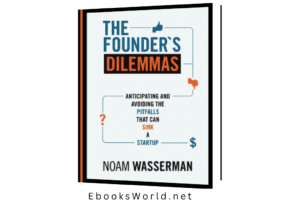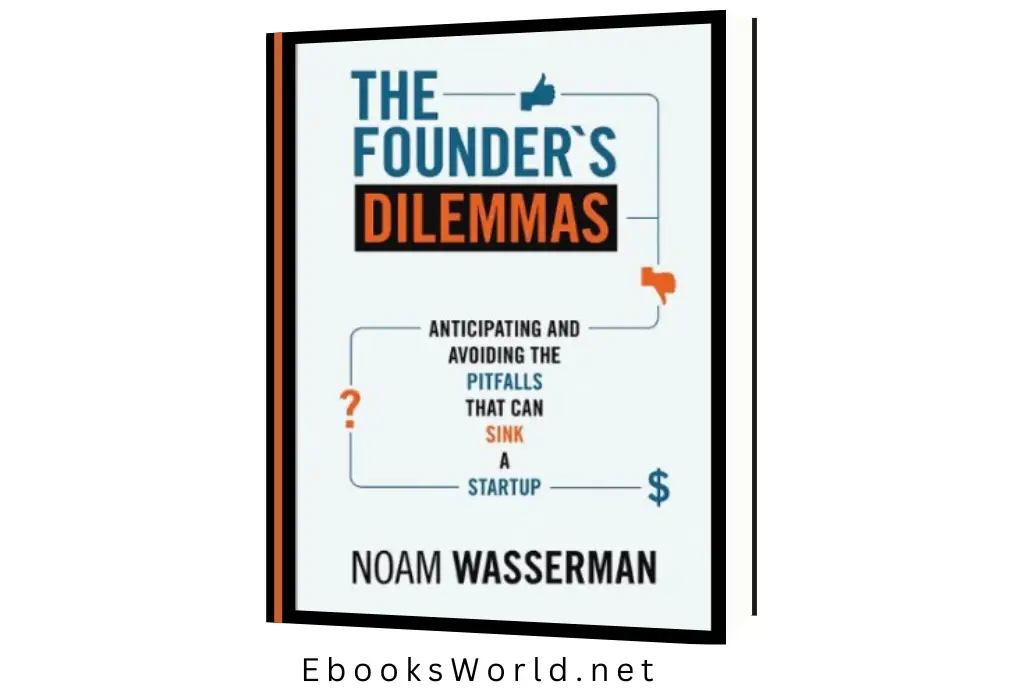The Founder’s Dilemmas: Anticipating and Avoiding the Pitfalls That Can Sink a Startup

Ratings
“The Founder’s Dilemmas: Anticipating and Avoiding the Pitfalls That Can Sink a Startup” by Noam Wasserman is a comprehensive exploration of the challenges entrepreneurs face in the early stages of building a startup. Published in 2012, the book draws on extensive research and case studies to provide insights into the critical decisions founders must make and the potential consequences of those decisions. Wasserman, a professor at Harvard Business School, combines academic rigor with practical advice, making the book a valuable resource for aspiring entrepreneurs, investors, and anyone interested in the dynamics of startup success and failure.
Key Themes:
1. Co-founder Dynamics:
Wasserman delves deeply into the complexities of co-founder relationships, highlighting the crucial role that these partnerships play in a startup’s success or failure. He introduces the concept of “the three Rs” – relationship, roles, and rewards – emphasizing that misalignment in any of these areas can lead to serious problems down the road. Through case studies, the book explores various scenarios, from co-founder breakups to the impact of unequal contributions and divergent visions.
2. Equity Distribution:
The issue of equity distribution among founders is a central theme. Wasserman argues that determining the right equity split is one of the most critical decisions founders make. He discusses the challenges of dividing equity fairly, taking into account factors such as initial contributions, time commitment, and evolving roles. The book provides practical frameworks for navigating these decisions and avoiding common pitfalls.
3. Decision-Making:
Founders often face tough decisions related to hiring, firing, and strategic direction. Wasserman examines the psychological and emotional challenges tied to these decisions, emphasizing the importance of making choices that align with the company’s long-term goals. The book explores the impact of early decisions on a startup’s trajectory and warns against the dangers of compromising long-term success for short-term gains.
4. Investor Relationships:
Wasserman addresses the complexities of relationships between founders and investors. He explores the different types of investors, their expectations, and the potential conflicts that may arise. The book provides guidance on managing investor relationships to ensure alignment of interests and minimize the risk of founder-investor conflicts.
5. Advisors and Board Members:
The role of advisors and board members in guiding a startup is another focal point. Wasserman discusses the selection, management, and potential conflicts with these key stakeholders. The book emphasizes the strategic importance of building a supportive network of advisors and board members who can contribute valuable insights and help navigate challenges.
6. Exits and Endings:
Wasserman dedicates a section to the various exit strategies available to founders, such as acquisition or initial public offering (IPO). He explores the emotional aspects of letting go and the importance of timing when considering an exit. The book provides a nuanced view of the factors founders should weigh when deciding to sell or continue building their companies.
Strengths:
1. Research-Based Approach:
One of the book’s strengths is its rigorous research foundation. Wasserman draws on a wealth of data, including surveys of thousands of founders, to support his arguments and conclusions. This empirical approach lends credibility to the book’s insights, making it a valuable resource for both academics and practitioners.
2. Practical Guidance:
While rooted in academic research, “The Founder’s Dilemmas” is highly practical. Wasserman provides actionable advice and frameworks that founders can apply to their specific situations. The book goes beyond theoretical discussions, offering real-world examples and case studies to illustrate the challenges and solutions presented.
3. Comprehensive Coverage:
The book covers a wide range of topics relevant to startup founders. From co-founder dynamics to equity distribution, decision-making, investor relationships, and exits, Wasserman leaves few stones unturned. This comprehensive coverage ensures that readers gain a holistic understanding of the challenges they may encounter on their entrepreneurial journey.
4. Relevance to Various Stakeholders:
“The Founder’s Dilemmas” is not only relevant to founders but also to investors, advisors, and anyone involved in the startup ecosystem. The insights provided can help investors better understand the challenges founders face, enabling more effective collaboration and support. Similarly, advisors and board members can use the book to navigate their roles more effectively.
Weaknesses:
1. Limited Cultural and Industry Diversity:
One notable limitation is the book’s focus on the U.S. startup ecosystem. While many of the principles discussed are likely applicable in various contexts, the book could benefit from a more diverse range of cultural and industry perspectives. Startups in different regions and industries may face unique challenges not fully captured in the book.
2. Evolution of the Startup Landscape:
Published in 2012, some aspects of the book may be outdated in the rapidly evolving world of startups. The startup landscape, investor expectations, and industry norms may have shifted since the book’s release. Readers should complement the book with updated sources to ensure they are aware of the latest trends and developments.
Conclusion:
“The Founder’s Dilemmas” by Noam Wasserman is a seminal work that offers valuable insights into the challenges faced by startup founders. Its combination of rigorous research and practical advice makes it a must-read for anyone involved in the startup ecosystem. By exploring the intricacies of co-founder relationships, equity distribution, decision-making, investor dynamics, and exits, Wasserman provides a roadmap for founders to navigate the complexities of entrepreneurship. While the book has some limitations, such as its U.S.-centric focus and potential for outdated information, its enduring relevance and wealth of practical guidance make it an enduring resource for those embarking on the entrepreneurial journey.







